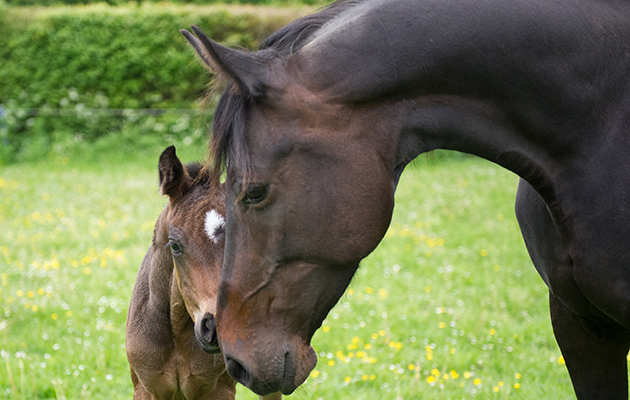More articles on broodmares
View broodmares for sale
Many mares that fail to conceive are suffering from infections in their reproductive tracts; they are referred to as “dirty” mares. Dirty mares either have, or are at risk of, inflammatory changes involving the lining of the womb (endometrium). This is called endometritis (literally: inflammation of the lining of the uterus). Mares with endometritis may either fail to conceive in the first place or will undergo early loss of the pregnancy.
While the term “dirty mare” is in common usage in breeding, it is not always appreciated that such horses usually fit into three categories:
- mares with acute infection of the uterus
- mares with long-term uterine infection, often with scar tissue
- mares susceptible to infection after breeding
Acute infection
The vulva provides the first effective barrier to protect the uterus from infection and poor vulval shape can lead to infection. The vulval lips meet evenly in the midline in the normal mare. If the vulval seal does not work properly, contamination of the vagina can occur. The initial vaginitis may lead to acute uterine infection, resulting in a dirty mare.
Diagnosis of infection can be made by collecting swab and smear samples when the mare is in oestrus (during early heat or season). The swabs are examined for bacteria and the presence of pus cells.
Acute uterine infection is found most frequently in older mares that have had several foals. Treatment involves the infusion of antibiotics into the uterus. The number of treatments required depends on individual circumstances, but daily infusions for five days during heat work well in most cases.
Predisposing causes of the persistent infection, such as defective vulval conformation, should also be attended to. This usually means a minor surgical procedure in which the upper part of the vulva is sutured together.
Long-term uterine infection
These mares have scar tissue in the uterus and a severe infection has often been present for a long time. Successful treatment of this category of dirty mare is difficult and fertility remains poor whatever treatment is used.
Persistent infection after breeding
Persistent infection induced by breeding (natural or by artificial insemination) is the most important category of dirty mare. All mares develop an acute inflammation of the uterus after breeding. This used to be blamed on bacterial contamination of the uterus at the time of breeding, but it is now realised that the sperm themselves, as well as bacteria, are responsible.
A transient uterine inflammation, visible as fluid on an ultrasound scan, is useful as it clears the uterus of excess sperm and debris associated with breeding before the tiny embryo implants.
In most mares, this fluid resolves spontaneously within 24-48hr so that the internal environment of the uterus is compatible with pregnancy. However, if the inflammatory fluid persists for more than three or four days this may cause a problem.
Susceptible mares are often older, with uterine muscles that have lost the ability to contract properly. In other mares, particularly older maiden animals, the cervix does not open sufficiently to allow fluid to drain from the uterus.
In such cases the following management measures can help maximise the chances of producing a live, healthy foal:
- Hygiene: good hygiene is essential at breeding and all gynaecological examinations should be performed as aseptically as possible. Pay attention to hygiene at mating by using a tail bandage and washing the mare’s vulva and perineal area with clean water (ideally from a spray nozzle, which avoids the need for buckets).
-
Correct timing of breeding: breeding should occur at the optimal time, so, ideally, the mare needs only to be covered by the stallion once. This means that such mares need very close monitoring to predict ovulation. A single breeding two days before the anticipated ovulation is ideal, provided natural cover or artificial insemination with fresh semen is used. Most sperm are viable at least 48-72hr after breeding.
This early breeding allows more time for drainage of fluid via an open cervix and also utilises the natural resistance of the tract to inflammation during oestrus. It allows sufficient time to flush the mare more than once before ovulation if necessary. When feasible, the use of artificial insemination with fresh semen can help to reduce the inevitable post-breeding endometritis.
-
Ultrasound scanning of the uterus: for detection of uterine fluid, in addition to conventional techniques of smears and swabs, before breeding, to reveal high-risk mares. Doses of oxytocin are given every 4-6hr after breeding. Ultrasound examination of the uterus the day after breeding is performed to assess the amount of any intrauterine fluid. If excessive (more than 2cm) fluid is present, the uterus is flushed with warmed sterile saline using a special uterine flushing catheter.
Oxytocin should be given and the cervix checked. This may be followed by infusion of antibiotics. Further doses of oxytocin are given every 6hr. The mare is re-examined the following day and oxytocin treatment repeated if fluid is still present.
A dirty mare, once inseminated or bred, should not only be checked for ovulation but also for fluid accumulation in the uterus. This is one of the most reliable clinical signs of susceptibility to post-breeding endometritis. If such a mare is identified, intensive post-breeding monitoring and treatment is necessary in order to improve the chances of conception.
This feature, including a case study not included here, was first published in Horse & Hound (22 July)
Looking for more articles on broodmares?
View broodmares for sale near you



